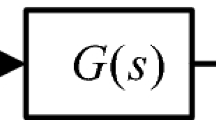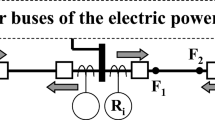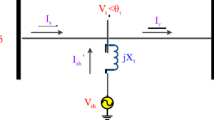Abstract
When designing or extending electricity grids, both frequency stability and resilience against cascading failures have to be considered amongst other aspects of energy security and economics such as construction costs due to total line length. Here, we compare an improved simulation model for cascading failures with state-of-the-art simulation models for short-term grid dynamics. Random ensembles of realistic power grid topologies are generated using a recent model that allows for a tuning of global vs local redundancy. The former can be measured by the algebraic connectivity of the network, whereas the latter can be measured by the networks transitivity. We show that, while frequency stability of an electricity grid benefits from a global form of redundancy, resilience against cascading failures rather requires a more local form of redundancy and further analyse the corresponding trade-off.
Similar content being viewed by others
References
50hertz, http://www.50hertz.com/Netzlast/Karte/index.html (accessed: 08.06.2015)
S.V. Buldyrev, et al., Nature, 464, 1025 (2010)
B.A. Carreras, et al., Chaos 12, 985 (2002)
P. Crucitti, V. Latora, M. Marchiori, Phys. Rev. E 69, 045104 (2004)
T. Dewenter, A.K. Hartmann, New J. Phys. 17, 015005 (2015)
J.F. Donges, Ph.D. thesis, Humboldt University, Berlin, Germany, 2012
F. Dörfler, F. Bullo, SIAM J. Control and Optimization 50, 1616 (2012)
S.C. Srivastava, A. Velayutham, A.S. Bakshi, http://www.cea.nic.in/reports/articles/god/grid_disturbance_report.pdf (accessed: 27.04.2015)
Union of the Electricity Industry – EURELECTRIC, http://www.eurelectric.org/media/38999/eu_islands_-_towards_a_sustainable_energy_future_-_eurelectric_report_final-2012-190-0001-01-e.pdf (accessed 10.06.2015)
G. Filatrella, A.H. Nielsen, N.F. Pedersen, Eur. Phys. J. B 61, 485 (2008)
C. Folke, Global Environmental Change 16, 253 (2006)
A. Gajduk, M. Todorovski, L. Kocarev, The Euro. Phys. J. Spec. Top. 223, 2387 (2014)
J. Gao, et al., Phys. Rev. Lett. 107, 195701 (2011)
J.J. Grainger, W.D. Stevenson, Vol. 31 (New York: McGraw-Hill, 1994)
F. Hellmann, et al., arXiv preprint [arXiv:1506.01257] (2015)
C.S. Holling, Ann. Rev. Ecology and Systematics 4, 1 (1973)
P. Holme, et al., Phys. Rev. E 65, 056109 (2002)
Intergovernmental Panel on Climate Change, http://www.ipcc.ch/pdf/assessment-report/ar5/syr/SYR_AR5_FINAL_full.pdf (accessed: 27.04.2015)
J.C. Kile, et al., Prehospital, Florian, and disaster medicine 20, 93 (2005)
J. Machowski, J. Bialek, J. Bumby (John Wiley & Sons, 2011)
P.J. Menck, et al., Nat. Phys. 9, 89 (2013)
P.J. Menck, et al., Nat. Commu. 5, 3969 (2013)
A.E. Motter, Y.-C. Lai, Phys. Rev. E 66, 065102 (2002)
D.E. Newman, et al., IEEE Transactions on 60, 134 (2011)
T. Nishikawa, A.E. Motter, New J. Phys. 17, 15012 (2015)
Renewable Energy Policy Network for the 21st Century, http://www.ren21.net/Portals/0/documents/Resources/GSR/2014/GSR2014_full%20report_low%20res.pdf (accessed: 27.04.2015)
M. Rohden, et al., Phys. Rev. Lett. 109, 064101 (2012)
K. Schmietendorf, et al., Eur. Phys. J. Special Topics 223, 2577 (2014)
P. Schultz, J. Heitzig, J. Kurths, Eur. Phys. J. Special Topics 223, 2593 (2014)
P. Schultz, J. Heitzig, J. Kurths, New J. Phys. 16, 125001 (2014)
I. Simonsen, et al., Phys. Rev. Lett. 100, 218701 (2008)
R.V. Solé, et al., Phys. Rev. E 77, 026102 (2008)
Union for the Co-ordination of Transmission of Electricity, http://www.entsoe.eu/fileadmin/user_upload/_library/publications/ce/otherreports/Final-Report-20070130.pdf (accessed: 27.04.2015)
D. Witthaut, M. Timme, New J. Phys. 14, 083036 (2012)
Author information
Authors and Affiliations
Corresponding authors
Rights and permissions
About this article
Cite this article
Plietzsch, A., Schultz, P., Heitzig, J. et al. Local vs. global redundancy – trade-offs between resilience against cascading failures and frequency stability. Eur. Phys. J. Spec. Top. 225, 551–568 (2016). https://doi.org/10.1140/epjst/e2015-50137-4
Received:
Revised:
Published:
Issue Date:
DOI: https://doi.org/10.1140/epjst/e2015-50137-4




